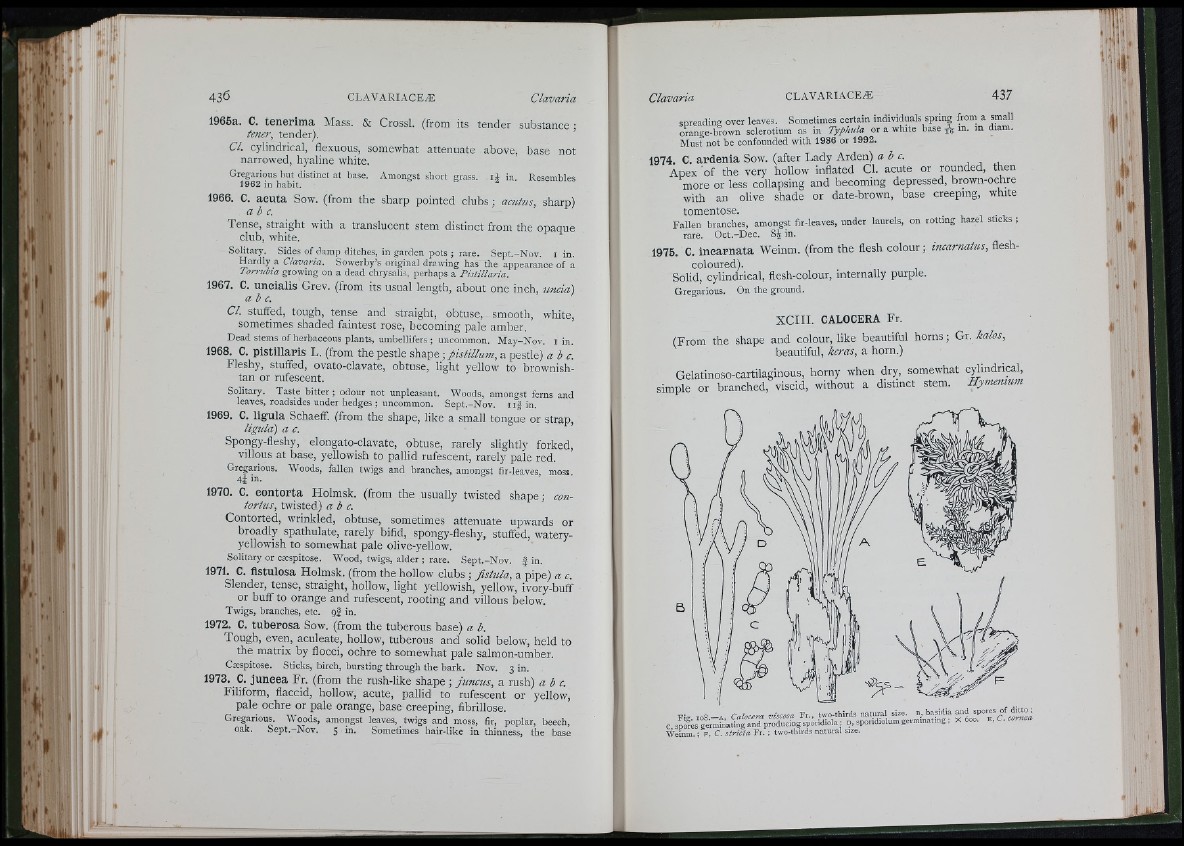
436
1965a. C. tenerima Mass. & Crossl. (from its tender substance;
tener, tender).
Cl. cylindrical, flexuous, somewhat attenuate above, base not
narrowed, hyaline white.
Greg.-irious but distinct at base. Amongst short grass, i® in. Resembles
1962 in habit.
1966. C. aeuta Sow. (from the sharp pointed clubs ; acutus, sharp)
abc.
Tense, straight with a translucent stem distinct from the opaque
club, white.
Solitary. Sides of damp ditches, in garden pots ; rare. Sept.-Nov. i in.
Hardly a Clavaria. Sowerby’s original drawing has the appearance of a
Torrubia growing on a dead chrysalis, perhaps a Pistillaria.
1967. C. uneialis Grev. (from its usual length, about one inch, uncia)
abc.
Cl. stuffed, tough, tense and straight, obtuse, smooth, white,
sometimes shaded faintest rose, becoming pale amber.
Dead stems of herbaceous plants, umbellifers ; uncommon. May-Nov. i in.
1968. C. pistillaris L. (from the pestle shape ; pistilluin, a pestle) abc.
Fleshy, stuffed, ovato-clavate, obtuse, light yellow to brownishtan
or rufescent.
Solitary. Taste bitter; odour not unpleasant. Woods, amongst ferns and
leaves, roadsides under hedges ; uncommon. Sept.-Nov. i i f in.
1969. C. ligula Schaeff. (from the shape, like a small tongue or strap,
ligula) a c.
Spongy-fleshy, elongato-clavate, obtuse, rarely slightly forked,
villous at base, yellowish to pallid rufescent, rarely pale red.
Gregarious. Woods, fallen twigs and branches, amongst fir-leaves, moss
4 i in-
1970. C. eontorta Holmsk. (from the usually twisted shape; cantor
tiis, twisted) abc.
Contorted, wrinkled, obtuse, sometimes attenuate upwards or
broadly spathulate, rarely bifid, spongy-fleshy, stuffed, watery-
yellowish to somewhat pale olive-yellow.
Solitary or cæspitose. Wood, twigs, alder ; rare. Sept.-Nov. J in.
1971. C. flstulosa Holmsk. (from the hollow clubs ; fistula, a pipe) a c.
Slender, tense, straight, hollow, light yellowish, yellow, ivory-buff
or buff to orange and rufescent, rooting and villous below.
Twigs, branches, etc. g f in.
1972. C. tuberosa Sow. (from the tuberous base) a b.
Tough, even, aculeate, hollow, tuberous and solid below, held to
the matrix by flocci, ochre to somewhat pale salmon-umber.
Cæspitose. Sticks, birch, bursting through the bark. Nov. 3 in.
1973. ^ C. juneea Fr. (from the rush-like shape ; juncus, a rush) abc.
Filiform, flaccid, hollow, acute, pallid to rufescent or yellow,
pale ochre or pale orange, base creeping, fibrillose.
Gregarious. Woods, amongst leaves, twigs and moss, fir, poplar, beech,
oak. Sept.-Nov. 5 in. Sometimes hair-like in thinness, the base
spreading over leaves. Sometimes certain individuals spring from a small
orange-brown sclerotium as in Typtmla or a white base A “ • “ diam.
Must not be confounded with 1986 or 1992.
1974. C. ardenia Sow. (after Lady Arden) abc . , , ,
Apex of the very hollow inflated Cl. acute or rounded, then
more or less collapsing and becoming depressed, brown-ochre
with an olive shade or date-brown, base creeping, white
tomentose. . , , • ,
Fallen branches, amongst fir-leaves, under laurels, on rotting hazel sticks ;
rare. Oct.-Dec. 8® in.
1975. C. inearnata Weinm. (from the flesh colour; incarnatus, fleshcoloured).
Solid, cylindrical, flesh-colour, internally purple.
Gregarious. On the ground.
XCIII. CALOCERA Fr.
(From the shape and colour, like beautiful horns; Gr. kalos,
beautiful, kcras, a horn.)
Gelatinoso-cartilaginous, horny when dry, somewhat cylindrical,
simple or branched, viscid, without a distinct stem. Hymemum
c, s p / r g e r m b a d n l T n T p r / " c T n g / t i i r i ^ L i ’ E, C. coniea
Wemm. ; f , C. s tr ic ta F r. ; two-thirds n atu ral size.